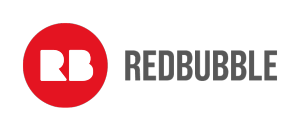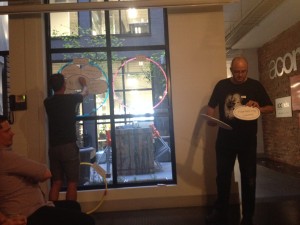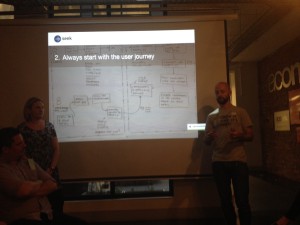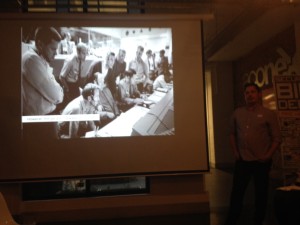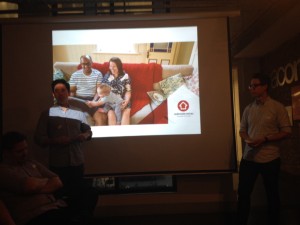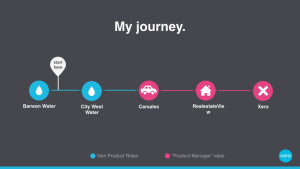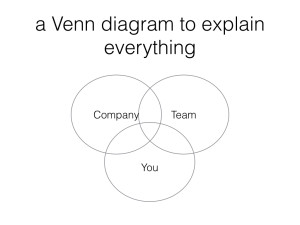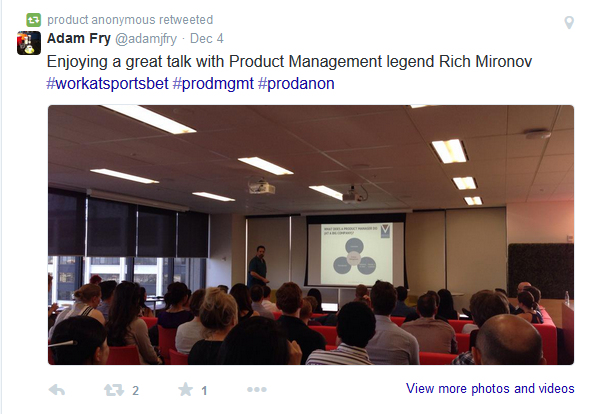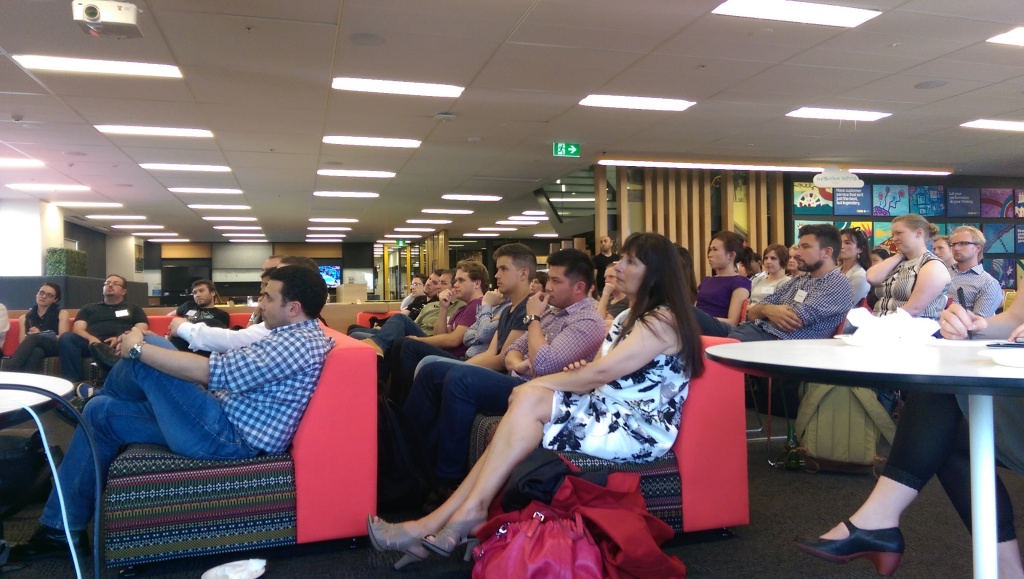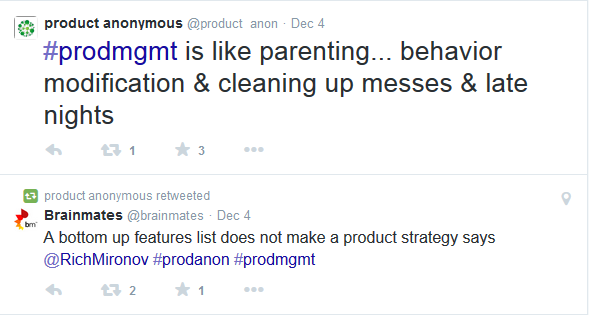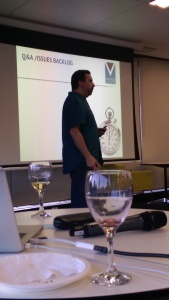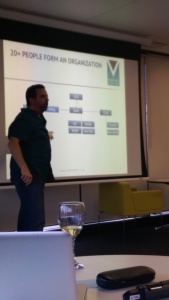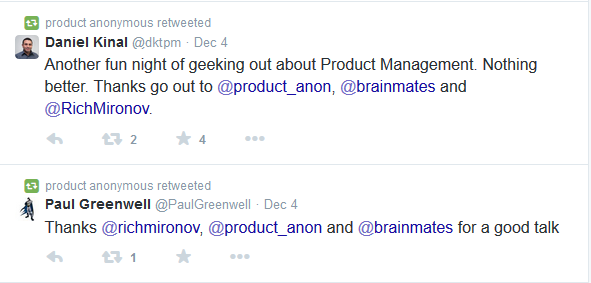March wrap: Enhance your communication skills with sketching
This month, Rebecca Jackson, sketchnoter extraordinaire helped us communicate more visually and Brainmates very kindly sponsored the evening!
Our brains are wired to understand and remember images more than words, so how can we put forward our ideas visually to take advantage of the way our brains work? The premise was that if we learn to draw what we are hearing rather than writing a long diatribe of words, not only will we remember better what we heard, we will have an easier reference tool to explain and share what we have learnt with others.
Rebecca focused on the sketchnote approach as a discipline one can practise to get better at forming ideas into visual memes and thus expanding our skills to prepare us to use this in any forum. What often limits people is their notion of “I cannot draw” and thus revert back to words and traditional formats. What sketchnoting showed us, first of all, you can use alot of words and still be sketching! This example has NO drawings at all 🙂
@product_anon sketch noting for fun, profit and mental clarity pic.twitter.com/odXfXQEHe3
— Steve Bauer (@stevecares) March 19, 2015
Then Rebecca showed us how we can practice (without too much social ridicule) to allow us to build confidence to use drawing and sketching publicly.
Once again the best at the visuals! @GeorgeCockerill@product_anon@_rebeccajackson#sketchnotespic.twitter.com/FyquIfoE2J
— product anonymous (@product_anon) March 19, 2015
The second thing to consider with sketchnoting, although we didn’t get to talk about this as much due to time, was what it offered as a presentation tool itself. Instead of preparing a powerpoint with lots of bullet points and words, a sketchnote could be used to be the communication tool. The power of the sketchnote for this purpose is you are still needed to provide a verbal presentation – which is often forgotten in presentations these days – but you have a much better cue card for yourself to do the talking!
The structure of the session did give us a bit of an overview of why it can be valuable to use visual tools to remember things, and once upon time was a fundamental approach to memory retention before we could quickly look it up on the internet or rely on presentation notes. Rebecca had us try using two Ted talks – this allowed us to give it a go and appreciate how “hard” it is and then have another go and notice it already gets a bit easier the second time around.
@product_anon #sketchnotes pic.twitter.com/X3HqnjyVZ6
— Sally Pryor (@Pryor365) March 19, 2015
A couple of comments from the group after their first effort – was it seemed hard and “the speaker was talking too fast” – which might be easy to interpret as bad choice of video. However, in having to draw to take notes, the brain was definitely being challenged to do something new while listening at the same time. It is important to remember that riding a bike the first time isn’t easy, and practice really is important to build a habit.
@product_anon making progress! pic.twitter.com/QH2se7eToT
— Luke Meehan (@lukasm) March 19, 2015
My personal observation was that even by the second attempt, it was easier to listen and sketch. And I certainly observed that I retained more information from the two talks than I would have if I had just sat there and listened or wrote my usual scrappy style. Lastly, I have an immediate visual tool to share what I learnt from those sessions than I would if I had just taken notes. The memory jogger style of the sketchnote is something I had not appreciated until I had tried it
#sketchnote here is my first attempt @product_anon http://t.co/F1ynivE2mo — Liz Blink (@liz_blink) March 19, 2015
The friendly crowd at @product_anon sketching away 😀 #prodmgmt #sketchnotes pic.twitter.com/aBdQ6So5pe
— Rebecca Jackson (@_rebeccajackson) March 19, 2015
My #sketchnotes from the #prodanon meetup on #sketchnoting. How meta! pic.twitter.com/ToQXLW7rwV
— Lisa Overton (@notrevol) March 19, 2015
My first #sketchnote attempt at tonight's @product_anon session. An interesting experience. Thanks @_rebeccajackson! pic.twitter.com/C1wjZKlm3D
— Daniel Kinal (@dktpm) March 19, 2015
My 1st #sketchnote incl my little pony and Hulk Hogan's moustache and arrows @product_anon @_rebeccajackson pic.twitter.com/2KQwcB2PC8
— Koen (@KoenLex) March 21, 2015
Try it yourself with Rebecca’s presentation below and the links to the TED talks we used then take a pix & tweet it out to us!
How do *you* manage products?
Often it seems the product manager role is different depending on where you work, who you work with, what stage the company is in & the current understanding of the value of product management.
Three companies will share how they work and manage product – their structure, how they work with other teams, their challenges and how the team brings value to the business. Each company will give a short presentation on their area and then we will throw to the audience for questions.
Redbubble – will talk about the differences and likenesses between physical and web product development. Nick Cust, Product Director and Vicki Stirling, Physical Product Director will talk about each of their sides of the business to dive into the similarities and the distinction between them.
Envato – Envato boasts a community of over 5 million creatives, but dedicated Product Management is a relatively new concept for the company. While growing a team alongside rapid expansion in engineering, the Product team at Envato continually focus on better ways to meet the needs of their highly talented and passionate global community. Luke Meehan, Product Manager and Stewart Boon, Product Director will talk about how they get things done with a global, two sided community of authors and buyers.
Zendesk – Zendesk has 20 scrum teams on 4 different continents building customer service software. In his short presentation Aaron Cottrell will outline what has worked, what hasn’t and where Zendesk is continuing to improve as a globally distributed product company.
A big thank you to Redbubble for being our hosts for the evening! RSVP here.
February wrap: Product Managers are from Pluto* and UXers are from Uranus
There are a lot of similarities between Product Managers and UXers in how we think and the work we do but we also see things differently.
A fabulous panel of UX and Product Manager pairs spoke about how they work together collaboratively at their organisations. A lot of common themes came out of the talks, but also the individual styles and cultures of each of the companies presenting showed how important the set up can be to the individual experience.
This event could not have happened without the fabulous support of the product management team from Aconex and the lovely facilitation by Kirsten Mann (Director Customer Experience / UX and Online Support) to keep our speakers to time and inject wiseness and humour at the appropriate moments!
*The ‘object’ formerly known as the Planet
Our panel was made up of:
- Aconex – Mark Smith / Senior Product Manager & David McNamara / UX Designer
- Seek – Nicole Brolan / Product Manager & Vedran Arnautovic / Senior User Experience Designer
- MYOB – Russell Kallman / Senior Product Manager & Scott Turner / UX Design Lead
- REA – Chris Kwan / Consumer Product Manager & Ricky Synnot / Senior Experience Designer
Aconex / Mark + David
David and Mark kicked off the panel and used a few props to get their point across. David mentioned that he had once heard a great quote from Peter Merholz that stated “good UX is indistinguishable from excellent product mgmt”. That certainly brought some questions to mind as to what the reason is for defining and separating the roles, so David and Mark proceeded to use their hoola hoops to show us the differences (and the intention was to show the overlaps but the window space didn’t support that!)
Mark called out a whole bunch of tasks that are usually sitting in the PM circle – product strategy, market fit, competitor analysis and we can go on… and David listed out traditional UX tasks such as design, customer journey maps and more. Then the guys proceeded to swap their tasks from one circle to the other – because for them it sometimes just depends on time and need as to who does it. Not title or law.
Mark pointed out that since joining Aconex and getting the opportunity to work with David he has been really pleased to find he doesn’t need to do so-called UX tasks anymore. He had previously done them, as he didn’t really have someone else who did. So now he is really enjoying not having to do it and being able to rely on such fabulous quality work that David produces.
SEEK / Nicole + Vedran
Nicole and Vedran organised their thoughts into four key ares:
- Involve the UX-er early
- Always start with the user journey
- User testing is not just the UX-ers responsibility
- Product managers can design too (queue audience laughter for this one!)
Nicole shared with us that the Seek had only recently (1-2 years ago) begun to adjust their approach to include UX more closely in their product design and process. Seek had for a very long time been a strategic driven organisation and as a result saw the UX and design part as an later part of product design. Once the UX was being involved in the conversation early, including the strategy discussions, product have found it is a much easier and quicker ideation process because everyone understands the direction. Now it is just debating the nuances of button design (radio is best!) rather than the product purpose.
The call out about getting more of the team who will build the product involved in the user testing was well received by the audience. Perhaps in the opposite twist of the above observations, a lot can be lost in translation. If the UX-er is the only person who can provide a perspective on the customer need a lot of internal debate persists about what the customer problem is, instead of an argument about how best to solve the problem. The latter type of discussion obviously being a much preferred outcome as everyone is now contributing to the best product rather than which is opinion is more valuable.
Vedran spoke to the last point about product managers being able to design – i don’t know who was laughing more out of the audience, PM or UX – but Vedran’s point was that everyone should be able to contribute to the design process. It should not necessarily remain only the domain of the UX team/person as anyone can throw in a light bulb moment to the problem. If the first three steps have all been followed then the whole team is engaged, empathising and understanding the problem and thus all can contribute.
MYOB / Russell + Scott
The guys from MYOB took things in a slightly different direction from our first two speakers – they rejected the premise that UX-ers and PM’s are not getting along. They also shared a lot of space metaphors…..
The context Russell provided was that MYOB has been around a long time and enjoys considerable success with a significant market share. Disruptive competition has certainly challenged that position but that has brought about some positive changes, whereby UX and product were merged into the same teams. This has brought a lot of benefits to the relationships and the team dynamics because everyone is now set with the same objectives. It is perhaps other teams that they don’t play so well with now…!!
A common approach helps everyone remain pragmatic and everyone spends a lot of time with customers. There is very clear focus on ensuring plenty of lead time is provided to design before going to the engineers. There is nothing worse than setting up a team with design and engineering at the same time and then having engineering wait for UX. It puts too much pressure on that side, and leave engineers equally in a frustrating position.
They do have some situations that don’t work, despite things currently humming along well. When an individual comes in and wants to be a control freak or a rock star that isn’t so helpful. The other side of it that Scott pointed out was that sometimes the designer has to remember to let go of the gold plated version!
REA / Chris + Ricky
Last, but certainly by no means least Chris and Ricky talked us through their approach. They also had a little bit of a scene to set – as REA had been, for a time, always arranging staff into project teams for product development. This lead to very project focussed objectives that resulted in poor cohesion between projects, and accumulation of both tech and design debt. Chris described himself as the “crusher of dreams” as at times he just had to say no to good design as the project deadlines loomed.
Ricky shared this frustration at times needing to “talk up to the PM” to be able to get an idea across the line, as they were making the calls and their delivery pressures were creating tension between good design outcomes and budget/timelines. The intention had not been to create an informal hierarchy but it creeped in as a result of the environment.
REA realised they needed to change from this model and adjusted the teams accordingly. Both Ricky and Chris described how they then run specific cross-team sessions to keep abreast of what designers or product managers, respectively, are doing in other areas of the business. In terms of design this is particularly important to set out a UI toolkit /style guide to ensure end users do not get a clunky experience just because different teams are working asynchronously on the product.
Unfortunately, our 4th company, 99designs, were unable to make the session but have made their slide deck available. We hope to have Susan Teschner (product) & Catherine Hills (ux) at another Product Anonymous in the future.
Question time
We threw to the audience for questions – and there were a lot.
However, perhaps this is all best summed up by Rebecca Jackson – sketchnoting the evening (& see her blog post on the evening).
If you wish to learn from her on how to enhance how you communicate via sketching then come check out the next Product Anonymous session (Mar 19th is the next one) & follow us on Twitter @product_anon or any of the other social networks we live in.
Enhance your communication skills with sketching
Liz & I are very excited about our March session on visual communication (ok, we get really excited about all of our sessions but can you blame us for having such amazing speakers?!).
So much of the product manager job is communicating and since we deal with so many different groups in the business, we need to be able to communicate differently. This month, Rebecca Jackson, will help us communicate more visually…
Thursday March 19th
RSVP!
Our brains are wired to understand and remember images more than words, so how can we put forward our ideas visually to take advantage of the way our brains work? Rebecca Jackson, sketchnoter and visual communicator, will share how we can use visual note taking in meetings, presentations and life to explain, influence and remember.
Rebecca will cover:
- Why visual communication is awesome
- How to introduce it into your work & life
- Tools, tips & resources
- Real time practice, try sketching for yourself in the session
If you’ve sketched a wireframe, you have effectively used visuals to assist in communicating a shared vision. Take the next step and RSVP now for March 19th.
Rebecca Jackson is a Social Media Manager by day, visual communicator by night. She has a background in Intranets, Marketing and Retail and an interest in change management and user experience design. After recently re-discovering her love of visual communication she spends much of her spare time sketching. She’s also a bit of a sci-fi nerd who is known to jog and practice yoga.
Note: We recommend you bring along your notebook and pen(s) of choice so you can participate in this interactive session. (We will have on hand if you forget).
Breaking into Product Managment – General Assembly panel
Last week, General Assembly hosted a panel session on Breaking into Product Management for those interested in becoming a product manager or wondering how to get their 1st product manager job.
The panel included myself Liz Blink, Adam Fry from Sportsbet, Laura Cardinal from Xero and Brad Dunn from Nazori with Julien Viard from Rowben Consulting facilitating the discussion.
How to get started in Product Management
A theme that ran through each of the panelists’ presentations, was how they got started in the field, a taste of what the job is like and advice for those in the audience.
Laura Cardinal / Xero
Laura kicked off with her story – that she had been doing product management before she had her first job with those words in the title. She was working in customer service, and still dreaming of becoming a famous rock star, when she first was struck by a frustration at a problem that could be solved better, but had no idea how to go about implementing that idea.
Laura was working at a water company where plumbers would come in each day, on their way to their jobs to pay for and collect a print out of the house pipes for the job they were doing. Every day she’d listen to plumbers grumbling about the amount of time this took up, and in turn, she’d listen to the customer service reps grumble about the plumbers choice of deodorant – or lack there of.
The light bulb went off and what if they created a website where plumbers could access, download and print their own plans. With the amount of money that would save the business on printing paper and customer service, they wouldn’t even have to charge for it. At the time, Laura knew nothing about development, but surely that it could be done.
Laura talked to everybody that she could, would share her idea and solution with anyone who would listen and eventually she got the buy in she needed to implement her idea. All that talking and sharing and testing helped work through the refinement and iteration of the idea, and so they built the product. Laura had done enough convincing and managed to build a team around her to develop and launch what was called ‘Plumbers on-line’ and it still exists today… well a complete reincarnation of it anyway……
Her advice to those in the room who wanted to be in this space was to “fill your own scorecard with the skills you need” so that when you go for a product management role you already have everything you need to step into the role – without needing the title to sit on your resume.
Brad Dunn / Nazori
Brad drew our attention to the Apple retail experience and used that to highlight how paying attention to the right kind of data will really help you in a product management career.
His focus was very much on asking questions & using data until you really know why people do what they do. The Apple retail experience is one that very much contributes to the success of the product and is very precise. Nothing is done by accident in its layout including the angle the phones are rested on the bench.
The man behind this design, Ron Johnson, pioneered the concepts behind the store and came up with the Genius Bar. After Apple, he repeated his success and helped Target become “hip”.
However, this was not necessarily an easily repeatable approach because the exact opposite outcome occurred when he transformed JC Penney. Their stock price rose upon the announcement of his joining the company but the approach was the wrong one for JC Penney, the makeover did not work, the stock price plunged and he was fired.
Brad put this down to fundamental “attribution error” whereby one assumes that one internal element will determine the outcome & ignores that many other factors contribute to an outcome. In this instance, Ron Johnson helped Apple succeed with his retail store concept but there were other factors contributing to his success.
How do you avoid falling into the same trap & getting caught by this bias? Brad provided some guidance and suggestions. He suggested usability tools such as Usability Hub to get your designs and screens tested, get some A/B testing into your work, and he liked mixpanel over Google Analytics, especially the funnel component. Brad also had some favourite books to call out – he LOVES Eric Ries’ The Lean Startup and he said he lends the book Ten Faces of Innovation, by IDEO co-founder Tom Kelley, to clients before they start on projects together (& the clients rave about it).
Liz Blink / Sensis & Product Anonymous
Like Laura, I have also followed a rather unobvious path to being a product manager and was surely one before I stepped into a job with that title. I think product management is very much a mindset.
Having started out my life as a scientist I often get the question of “well how the heck did you get to this then” :-). The mindsets and the skillsets are so resusable – the curiosity that wants to get to the bottom of every problem, the need to know why, why, why, and the testing of a hypothesis to determine if that theory is true could describe either profession.
I talked a little about what you want to look for when looking for a product manager job- complete with a Venn diagram – it isn’t really a product management talk without one!
I was interested in what an individual might want to seek out for themselves as they choose a company to work for. Depending on the stage they are at, it might be looking for good support, mentoring and an opportunity to work at a company where you can eventually move into that role from within the company. This will give you a great opportunity to prove you have the mindset – something that is harder to prove than we might like to admit!
One circle in this Venn is to check where the company is at in its maturity of leading product managers, where do you sit in the organisation, who do you report to, what department are you in?
The other circle is what can you bring to the team? Do you have lots of technical skill but need to build up your people skills, your influence skills, your customer interview skills?
Every time you take a step, you want to understand what you need to bring to the team to ensure success, but also what you can learn from your team so you are developing your skill sheet further.
My last thought for my 5 minutes was really that as a product manager you are a little schizophrenic – you have to be empathic and constantly in tune with your customers and yet you will need to make tough, hard ass decisions – and you will have to make those calls as no one else will. I borrowed my quote from William Hsu – the constant balance between the fuzzy people stuff and the precise tech stuff. It’s a blast!
Adam Fry / Sportsbet
Last, but certainly not least, the polished Mr. Fry wrapped it all up beautifully for us with some fabulous pearls of wisdom.
Adam said that while he has been doing product management for awhile now, not a single one of those jobs has been the same so he talked a little about how a product manager should act.
If you mimic the process you won’t find yourself very successful nor it a very satisfying career! The core of the role stays the same though – you are the expert, the evangelist and a super sleuth. It is a little like being part of the United Nations – no authority & always the mediator. You are constantly challenged in everything you do, as someone always has an opinion and idea so you need to be ready to explain, defend and back yourself and your product decisions.
Sometimes you have to let people (including customers) down. When a feature hasn’t made it, part of your role is deciding who to tell & then to break the news to that stakeholder! Not an easy one – although when you get to announce great news/features/new products are coming it makes up for the bad news days…!
Thanks!
After the session, there were some great questions from the audience and a great set of conversations happening. Thanks to General Assembly for running the session and check out their course staring in February, where the one of your speakers, Adam Fry will be an instructor.
If you are looking to get into product management, come check out a Product Anonymous session (Feb 19th is the next one) & follow us on Twitter @product_anon or any of the other social networks we live in.
Breaking into Product Management session with General Assembly
There was a session at Product Camp this year about breaking into Product Management for those who are new to product management or are looking for their first product management job. If you missed that session or want to hear more, check out a free session from General Assembly this Thursday, January 22nd.
It’s a panel discussion with our very own Liz Blink and if you’ve been to any Product Anonymous sessions or Product Camp, you’ll recognise other faces like Adam Fry from Sportsbet and Laura Cardinal from Xero.
If you are looking for Product Management jobs then follow us on Twitter @product_anon
Product Managers & UX-ers: Working Well Together
There are a lot of similarities between Product Managers and UXers in how we think and the work we do but we also see things differently.
So on Feb 19th, we’re hosting:
Product Managers are from Pluto* and UXers are from Uranus – a practical guide for improving communication and getting what you want from your relationships
Hear from a panel of Product & UX folks and their secrets of working collaboratively with each other including:
• How they work together as a team
• What works? What doesn’t?
• Where are the potential conflict points between Product & UX – and how to prevent them!
• How they’ve changed their approach over time
The panel will take questions too – tweet #prodanon if you’re shy 🙂
6pm for 6:30pm start, and pizza & beverages sponsored by our lovely hosts Aconex.
Our Panel:
Aconex – Mark Smith / Senior Product Manager & David McNamara / UX Designer
MYOB – Russell Kallman / Senior Product Manager & Scott Turner / UX Design Lead
Seek – Nicole Brolan / Product Manager & Vedran Arnautovic / Senior User Experience Designer
99designs – Susan Teschner / Product Manager & Catherine Hills / User Experience Designer & Researcher
REA – Chris Kwan / Consumer Product Manager & Ricky Synnot / Senior Experience Designer
*The ‘object’ formerly known as the Planet
2015 dates added
If you subscribe to our Google Calendar, you might notice we’ve added the dates for Product Anonymous’ evening sessions in 2015 – starting with February 19th.
Things are already starting to fall into place for an exciting panel discussion on the 19th. More details to come early in the new year.
If you’re not subscribed to our Google Calendar, go to our Events page and click the ‘add calendar’ button on the bottom right of the embedded calendar.
December wrap: Product Management at Startups with Rich Mironov
We had a special guest, Rich Mironov, come to town in December – so Product Anonymous were very pleased to add an event into our 2014 calendar!
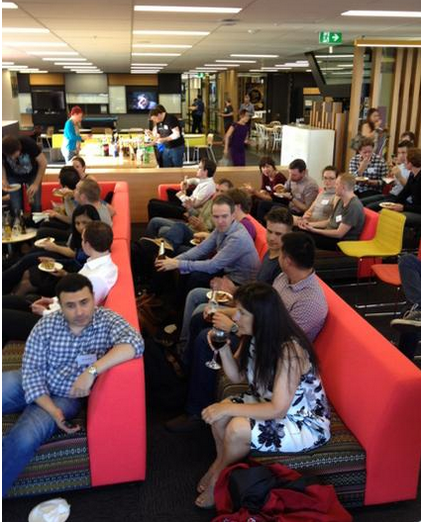 Rich gave a fabulous and funny talk about ‘Why you’ll (eventually) Need a Product Manager at your Start-up‘.
Rich gave a fabulous and funny talk about ‘Why you’ll (eventually) Need a Product Manager at your Start-up‘.
Within the talk Rich drew on his experiences as PM, consultant & start-up CEO regarding the value of product management for start-ups – one of which is about scaling your start-up for growth.
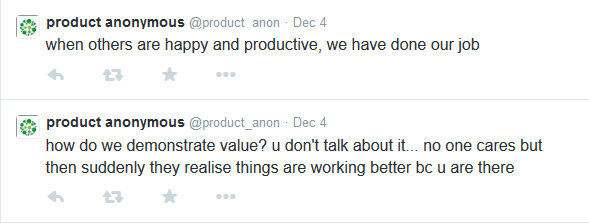 Rich has a ton of resources on his blog and especially referenced this area of the blog for more on the topic of organising teams. To keep up to date with more updates from Rich follow him on Twitter.
Rich has a ton of resources on his blog and especially referenced this area of the blog for more on the topic of organising teams. To keep up to date with more updates from Rich follow him on Twitter.
Thanks again to our hosts for the evening for such a fabulous location – Sportsbet – who also put on drinks and food for the event. And thanks everyone who came along on the evening.
See you in 2015!

